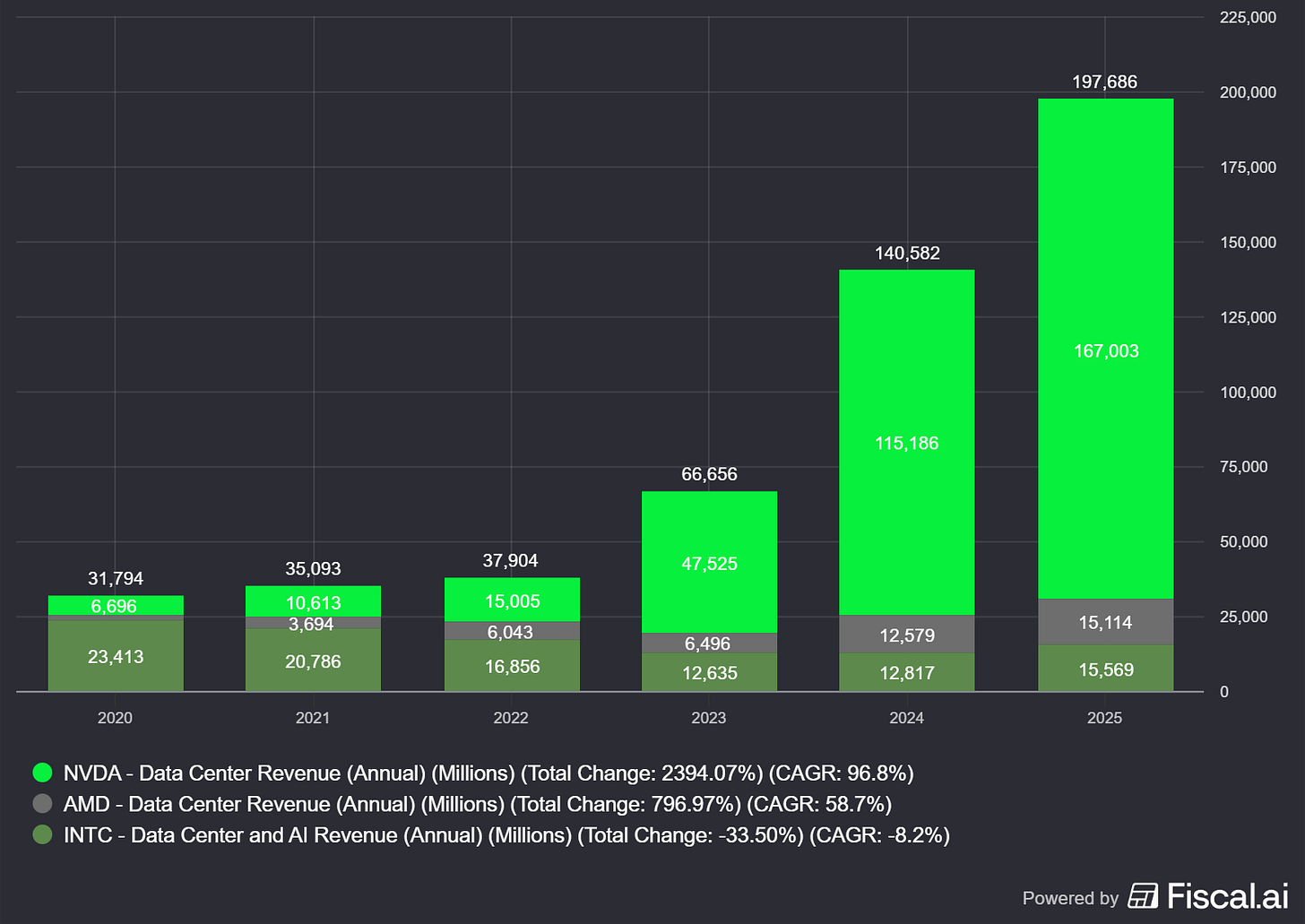AMD Valuation Update: Modeling the $1 Trillion Opportunity
Analyzing the new long-term targets and updating our valuation model
Last week, AMD held its Financial Analyst Day, outlining new long-term financial targets that exceeded even the most aggressive street expectations. Following our recent Q3 review where we noted the validation of the AI thesis, this event provided the quantitative roadmap for the next 5 years.
In this post, we break down management’s new targets, the drivers behind them, and incorporate these assumptions into our valuation model to derive AMD’s new fair value.
1. The $1 Trillion TAM
The headline figure from the event was the revision of the Data Center Total Addressable Market (TAM). Management now estimates the TAM will reach $1 Trillion by 2030 (up from the previous $500B by 2028 estimate), representing a CAGR of ~40%.
To put the ambition of this target into perspective, we must look at the current landscape. In today’s estimated ~$200 billion TAM, Nvidia’s dominance is staggering:
Nvidia: ~85% Market Share
AMD: ~7.5% Market Share
Intel: ~7.5% Market Share
Source: Fiscal.ai (affiliate link with a 15% discount for StockOpine readers)
AMD has now overtaken Intel and is targeting a double-digit share of that future $1 Trillion pie. The expansion is driven primarily by AI infrastructure, supported by the accelerated Capex guidance from hyperscalers.
Management’s Targets for the next five years:
Revenue Growth: >35% CAGR (Driven by >60% CAGR in Data Center and >10% in Client, Gaming and Embedded).
Gross Margin: Expansion to 55-58%.
Non-GAAP Operating Margin: >35%.
Profitability: Non-GAAP EPS power of >$20.
2. Drivers by Segment
Data Center
Overall, AMD expects the Data Center to grow at a >60% CAGR, with revenue from AI Accelerators (Instinct) driving the bulk of this expansion.
a. Data Center: AI Accelerators
AMD believes its Data Center AI business will be the primary growth engine, projecting a revenue CAGR of >80%. Assuming approximately $6.5 billion of revenue in FY25, this implies AI revenue will increase to ~$120 billion by 2030. If these targets materialize, Instinct GPUs would account for ~62% of total company revenue by 2030 (up from ~20% today).
We must take this with a grain of salt. To illustrate how optimistic this is: Analyst consensus expects Nvidia to grow revenue at only ~21% CAGR over the next 5 years (FY26 to FY31) to reach ~$560 billion. AMD is effectively guiding for hyper-growth by capturing market share from Nvidia. We note that this is not impossible, as AMD is starting from a much lower base.
The Driver: Growth in 2026 and beyond will be fueled by the launch of the MI450 and Helios rack-scale solutions, and later by the MI500 series.
The Share Gain: If these targets materialize, AMD will grow its GPU market share from ~4% today to ~14% by 2030 (assuming that $900B out of the $1T TAM relates to AI accelerators).
The OpenAI Factor: A major component of this ramp is the 6GW partnership with OpenAI. This deal alone has the potential to generate well over $100 billion, effectively underwriting nearly 40% of AMD’s total projected AI revenue for the period FY26-FY30. While this validates the technology, the thesis is heavily weighted on this single partnership.
b. Data center: CPUs
While GPUs grab the headlines, the CPU business remains the cash flow engine. AMD aims to expand its server CPU market share to >50% over the next 3-5 years (up from ~40% in FY25). With the upcoming “Venice” (Zen 6) architecture seeing strong customer pull, and hyperscalers needing more general compute to manage AI data pipelines, we view this target as highly achievable.
In fact, Lisa Su once again debunked the myth that AI makes CPUs irrelevant. They project that AI-driven workflows will generate $30 billion in additional CPU revenue by 2030.
Client & Embedded
Client: AMD is targeting >40% revenue market share by FY30 (up from ~28% today). Notably, they have already captured >50% share in the desktop market, proving they can beat Intel in core categories. A key tailwind for this segment has been the significant increase in Average Selling Prices (ASPs), which have grown 50% over the past two years. This structural improvement in pricing, supported by the upcoming “AI PC” cycle, is a critical contributor to the segment’s growth and gross margin expansion.
Embedded: After a cyclical correction, this segment is turning the corner expecting to deliver double digit growth QoQ in Q4’25. Design wins hit a record $16B in 2025 (+14% YoY). They expect to grow their FPGA revenue market share from an estimated ~55% today to >70% by FY30. As compute moves to the “Edge” (Robotics, Automotive), this high-margin business supports the corporate goal of gross margin expansion.
3. Valuation
We have updated our DCF model to reflect these new targets. Please note that the assumptions below for growth rates and margin expansion align with management’s aggressive guidance.


